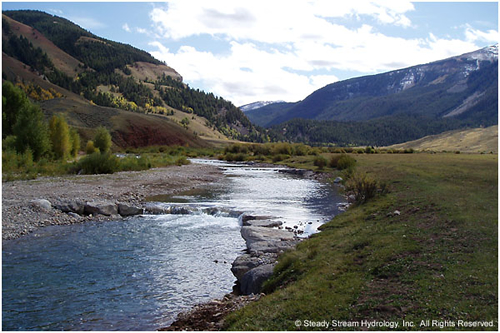Vanes
What is it?
Vanes are structures (typically made of logs or rock) built or placed into streams pointing upstream to direct stream flow velocites. They are either linear structures or slightly hooked structures (like "J" vanes) depending on stream size, flow velocities, and habitat restoration needs.
 (
photo from Steady Stream Hydrology)
(
photo from Steady Stream Hydrology)
Conservation Benefits
- Provides instream habitat for fish and other aquatic organisms
- Reduces streambank erosion and redirects flow to the center of the stream
What does it include?
Vanes are usually constucted from logs or rock. After a trench has been dug on the streambank, logs are anchored and rock vanes can be built out from the stream edge. Vanes are constructed to point upstream to more effectively direct stream flow and can be used to restore or create instream habitats like scour pools, enhancing riffles, and narrow over-widened streams. Vanes should be monitored for proper placement and effectiveness especially after large storm events.
Vanes Links
- Log, rock, and "J" vanes (p 129; Center for Watershed Protection)
- Rock vane/barb (p 20; Arizonia Department of Environmental Quality)
- Submerged vanes (p 278; Cooperative Research Centre for Catchment Hydrology)
Vanes Bibliography
- Crispell and Endreny. 2009. Hyporheic exchange flow around constructed in-channel structures and implications for restoration design. Hydrological Processes 23: 1158-1168.
- Johnson et al. 2002. Stream restoration in the vacinity of bridges. Journal of the American Water Resources Association 38: 55-67.
- Rosgen. 2004. The cross-vane, w-weir and j-hook vane structures: their description, design and application for stream stabilization and river restoration. Proceedings of Wetlands Engineering and River Restoration Conference 2001.